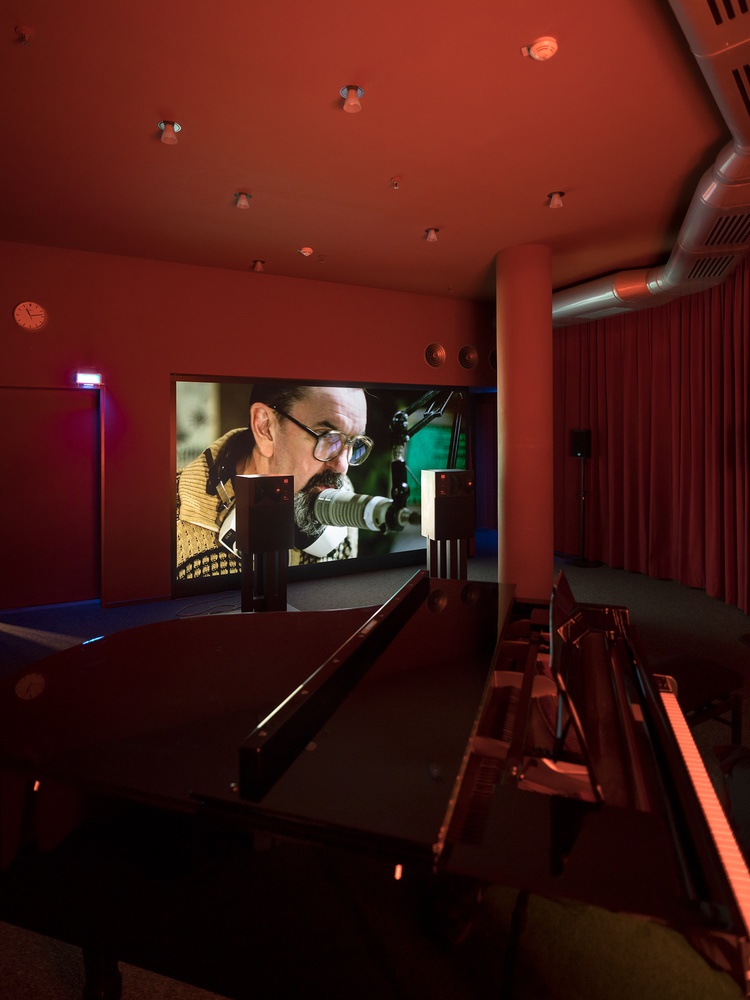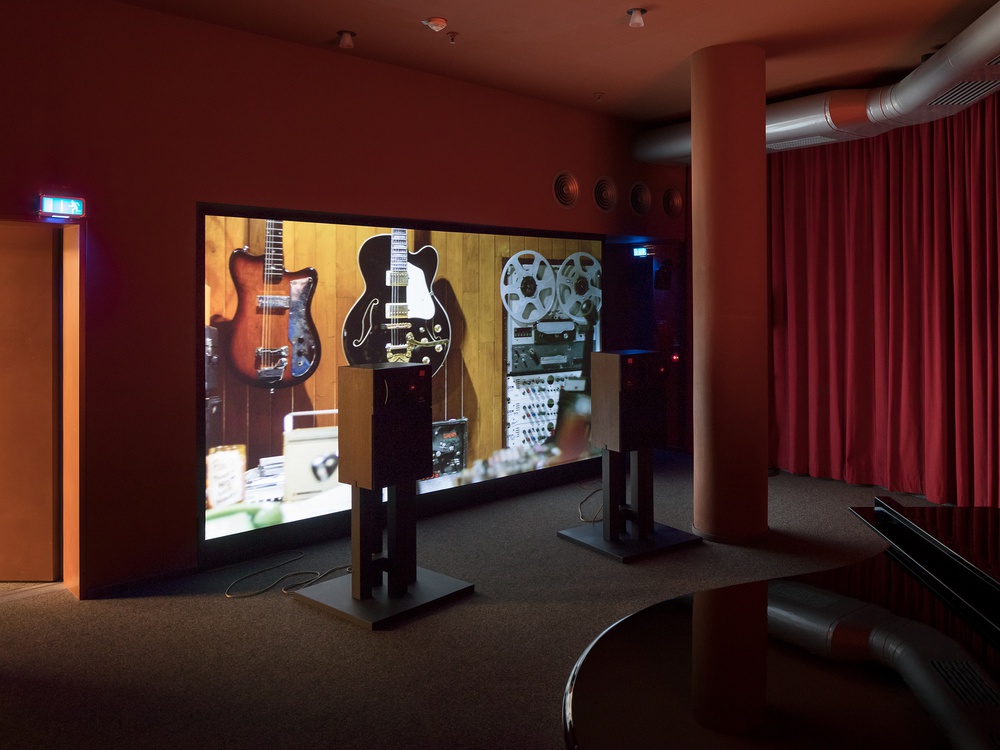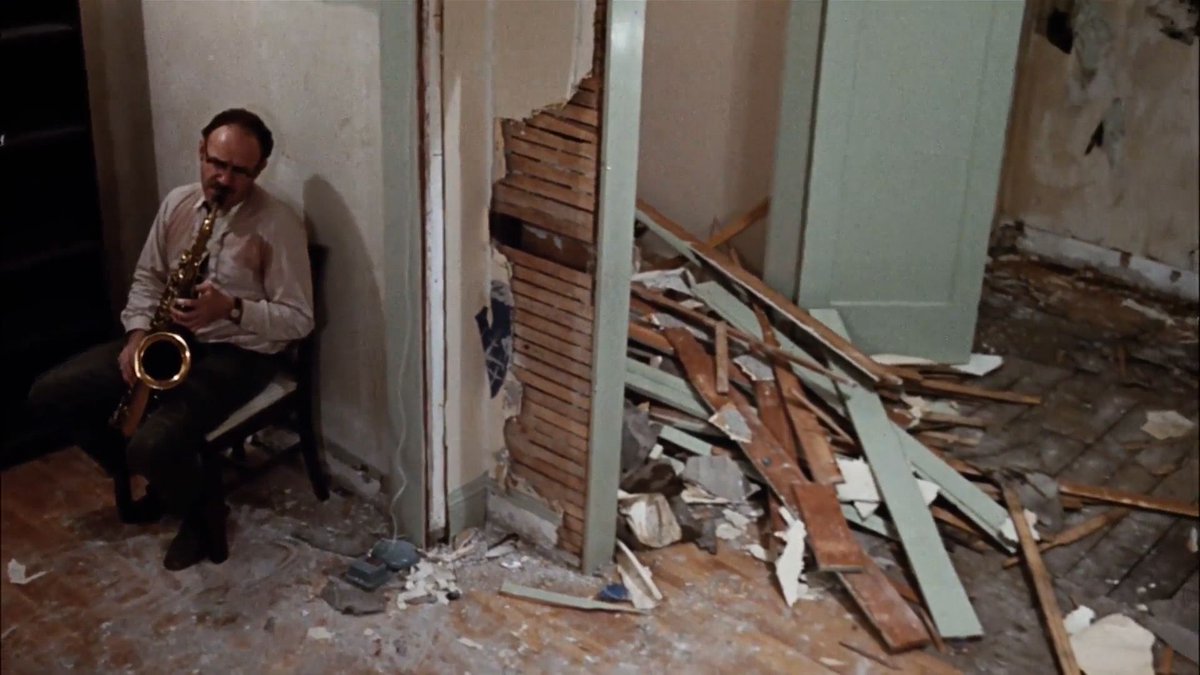“Recording in process – do not enter” reads the notice handwritten in capitals on a lamp cover; a radio jingle plays in the background. The picture focuses on a presenter reading out the weather forecast for the day, with Simon & Garfunkel’s “I am a Rock” providing the background music. The camera now steers our attention towards the radio studio, carefully leaving the interior and showing the audio-technical pride of the analog era in close-up shots: You can see capacitor microphones, tape recorders, record players and even a legendary tape delay.
You can tell me, I won’t tell anybody. Come on, tell us!
Musicians enter the recording room of the studio and carefully assemble their equipment: drums, bass amp, synthesizer. The presenter puts a caller on air, asking her over and over for her name and trying to get her to reveal the name of her new boyfriend in an increasingly unpleasant and insistent way: “You can tell me, I won’t tell anybody. Come on, tell us!”
Gerard Byrne’s video work “In Our Time”, commissioned in 2017 by Skulptur Projekte Münster, plays out in a past that not clearly defined, but one thing is clear: We are undoubtedly in the golden age of radio. The lavish tracking shots reveal that Byrne obviously put a great deal of care into the fittings and staging, yet the high-quality production value, the clear high-definition image and the flawless sound point to a clear rejection of any nostalgic vintage or retro look. Such ambiguities and contradictions keep arising during the course of “In Our Time”, even though they may not initially be apparent in the clear structure of the work: The radio presenter’s time checks, for example, make it clear that the duration of the work and the period covered by the narrative match, so it runs in real time.

Gerard Byrne, In Our Time, 2017, installation view, Skulptur Projekte Münster, Image via www.skulptur-projekte-archiv.de
After a good 30 minutes, something happens that is indicated only briefly in the subtitles of the work with “Video, varying length”. The video track returns to the beginning and repeats itself in a loop. Meanwhile, the sound runs for a good ten hours without any repetition: The time checks remain congruent with real time, and even the songs played on the radio change, as do the historical radio jingles and news segments. Further contradictions also become apparent: Not only does the name of the presenter change from segment to segment, but the radio station also changes its name – initially it’s referred to as KFOG, then later as KGBS or KGW. The radio DJ quickly announces a new cover of the Roy Orbison classic “Crying”, but then Townes van Zandt’s “Kathleen” begins instead.
Different time eras are woven into a new present
It is also impossible to assign a time period to the action: The historical news sequences refer to the murder of Alberta King, Martin Luther King’s mother, in the year 1974, but a short while later there is news of Reagan’s presidency during the 1980s. “In Our Time” thus appears like a temporal loop, by means of which various present days from different eras are woven together in a radio studio and run simultaneously.


Gerard Byrne, In Our Time, 2017, exhibition view, Skulptur Projekte Münster, photo: Henning Rogge, Image via www.skulptur-projekte-archiv.de
The form of the video work – the loops on the pictorial level with concurrently ongoing sound – consequentially translates the principle to the formal level. In the video, the crystal-clear HD image becomes almost like an anachronism, a view into the past from the future. But what does the present actually mean here? “What interests me is how the idea of the present takes shape in our culture. How is the present presented culturally and how does this change over the course of time?”, said Byrne in 2017, explaining the fundamental questions behind his way of working during a monographic show at the Kunstmuseum St. Gallen.
What interests me is how the idea of the present takes shape in our culture.
Previous works, which have been shown at Documenta, the Venice Biennale, Sydney, Lyon and Istanbul, for example, address these questions time and again. “In Our Time” appears immensely familiar, yet the longer you follow the action, the more the certainties disappear. For the second film, Gerard Byrne chose “The Conversation” from the year 1974. Francis Ford Coppola, who directed, produced it, and wrote the screenplay, once described the film as one of his best works.
Viewers are gradually drawn further and further into his world of paranoia
“The Conversation” is the story of a fateful bugging operation that surveillance expert Harry Caul (Gene Hackman) carries out for a private client. While this plotline has the makings of a reasonably intriguing, yet nevertheless arbitrary thriller, in Coppola’s hands it becomes an intense character study and a penetrating examination of the encroachment of technology in our private lives. Throughout the film, the camera does not stray from the side of protagonist Harry Caul, and viewers are gradually drawn further and further into his world of paranoia and remorse.

Francis Ford Coppola, The Conversation, 1974, Still, Image via cloudfront.net
Although Coppola wrote the screenplay for “The Conversation” back in the mid-1960s, he was not able to realize the film until several years later –amid the turmoil surrounding the journalistic revelations of the Watergate scandal. Alongside the widespread perception of Coppola’s work as a reaction to this setting – a crisis of confidence in politics, paranoia – there are unmistakable similarities with Michelangelo Antonioni’s “Blow Up”, shot in 1966. This likewise addresses questions of actual and supposed reality, here in relation to photography and the technical possibilities for its manipulation.
Coppola presents the audio technology used by the protagonists of “The Conversation” with just as much relish as Byrne does in his video work, and highlights the ambivalence of its usefulness over the course of the film: While it initially represents the foundation of Harry Caul’s professional activity and at the same time enables him to live out his control mania, it is ultimately revealed as precisely the opposite. This leaves the surveillance expert as a disillusioned, angst-ridden and embittered loner.

Francis Ford Coppola, The Conversation, 1974, Still, Image via twimg.com
